Introduction
Are you considering giving a budgerigar a second chance at a happy life? Adopting a budgerigar from a rescue organization can be a fulfilling and compassionate decision. In this blog post, we will guide you through the process of budgerigar rescue and adoption, providing you with all the essential information to make the best choice for you and your new feathered friend.
Budgerigars, often known as budgies or parakeets, are charming and intelligent birds that make wonderful pets. Unfortunately, many budgerigars end up in rescue centers due to various reasons, including abandonment, neglect, or owners unable to care for them anymore. By choosing to adopt a budgie, you are not only providing a loving home to a bird in need but also helping to reduce the demand for pet shops and breeders, thereby supporting animal welfare.
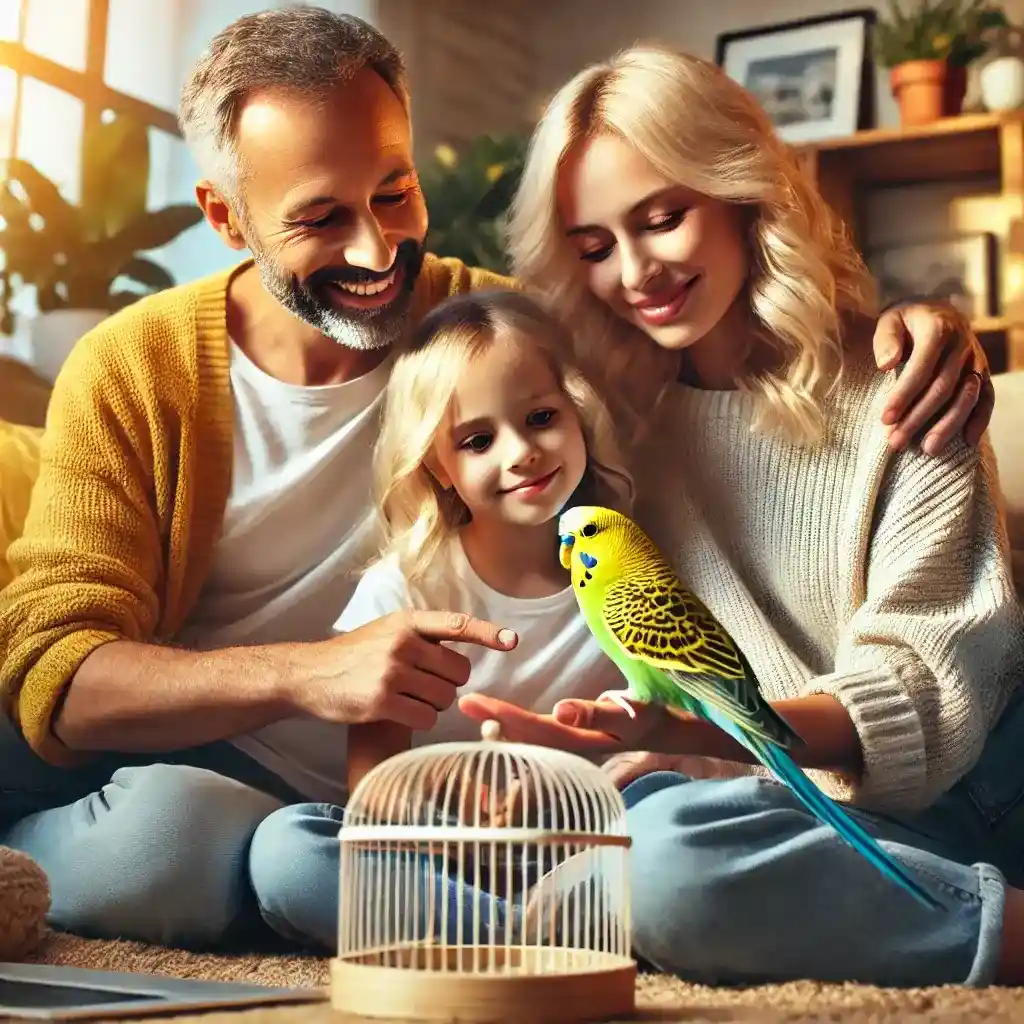
A joyful family enjoying quality time with their rescued budgerigar, showcasing the happiness that adoption can bring to both the bird and its new owners.
In this guide, you’ll learn why budgerigar rescue is important, how to find the right rescue organization, and what steps to take to ensure a successful adoption. We’ll also cover the basics of caring for your adopted budgerigar, from diet and health to socialization and enrichment. Whether you’re a first-time bird owner or looking to add another budgie to your flock, this post will equip you with the knowledge you need to provide a safe and happy home for your new pet.
Stay tuned as we explore the world of budgerigar rescue and adoption, offering tips, resources, and heartwarming success stories. By the end of this post, you’ll be ready to welcome a rescued budgie into your home and give them the second chance they deserve.
Understanding Budgerigar Rescue
Budgerigar rescue is a vital service that helps these charming birds find new, loving homes. But what exactly does budgerigar rescue involve, and why is it so important?
Budgerigar rescue organizations take in budgies that are abandoned, neglected, or surrendered by their owners. These birds may have faced various challenges, from inadequate care to health issues. Rescue centers work tirelessly to rehabilitate these budgies, ensuring they are healthy and well-socialized before finding them new homes.
One of the key reasons to consider budgerigar rescue is the opportunity to give a bird a second chance. Many budgies end up in shelters through no fault of their own. Their owners might have faced unforeseen circumstances that prevented them from providing the care these birds need. By adopting a rescued budgie, you are providing a safe and nurturing environment for a bird that truly needs it.
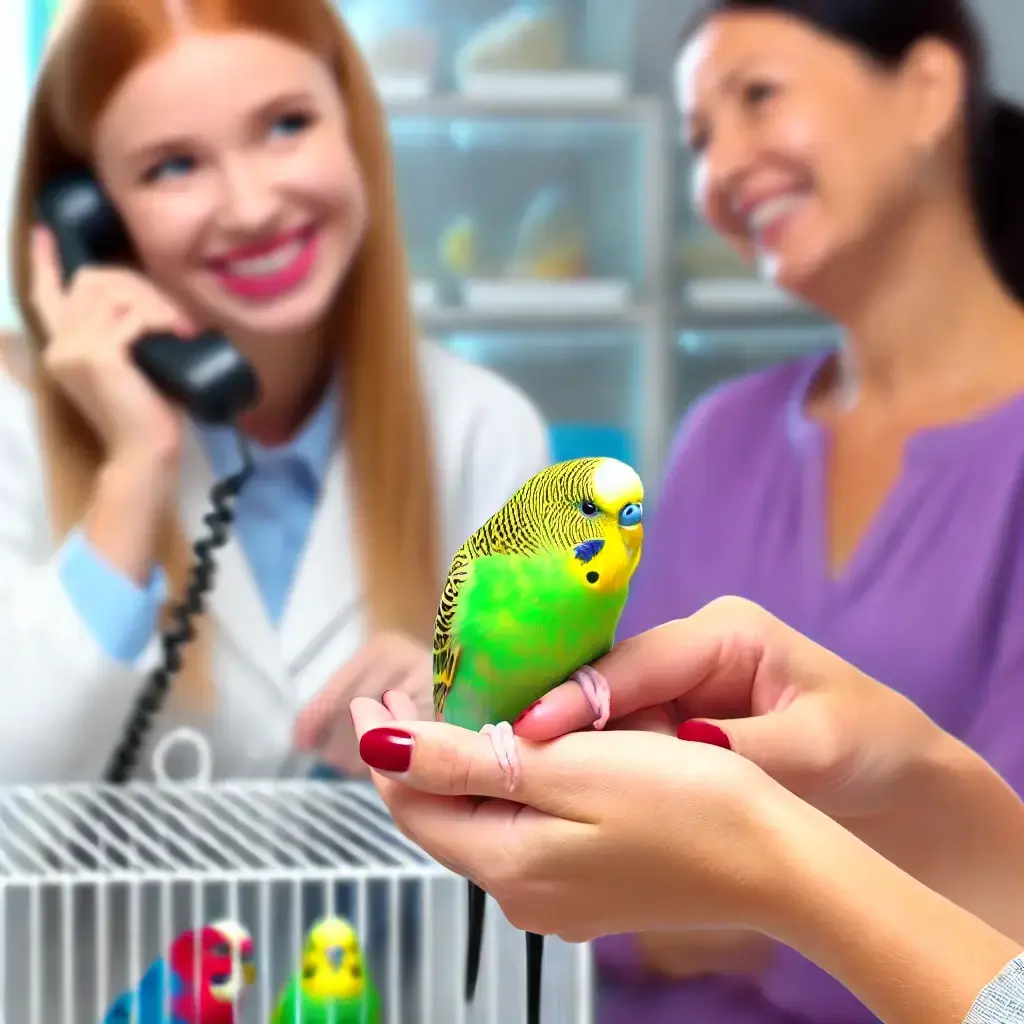
A budgerigar being examined and cared for at a rescue center, highlighting the importance of proper care and rehabilitation in the adoption process.
Budgerigar rescue also helps reduce the demand for pet shops and breeders. When you choose to adopt, you are supporting ethical practices and contributing to the overall welfare of these birds. This, in turn, helps to combat the overbreeding and poor conditions often found in some commercial breeding operations.
Understanding the process of budgerigar rescue is essential for potential adopters. Rescue organizations typically follow a structured process to ensure that each bird finds a suitable home. This process includes health checks, behavioral assessments, and matching birds with the right families. By working closely with rescue organizations, you can be sure that you are well-prepared to meet the needs of your new pet.
In summary, budgerigar rescue plays a crucial role in the well-being of these delightful birds. By choosing to adopt, you are making a positive impact on their lives and supporting ethical and compassionate practices. Whether you’re a first-time bird owner or adding to your feathered family, understanding budgerigar rescue is the first step towards providing a loving home for a budgie in need.
Why Consider Budgerigar Rescue and Adoption
Adopting a budgerigar from a rescue organization is not only a compassionate choice but also a rewarding experience. Here are several compelling reasons to consider budgerigar rescue and adoption.
Give a Bird a Second Chance
Many budgerigars end up in rescue centers due to circumstances beyond their control. These birds may have been abandoned, neglected, or surrendered by owners who could no longer care for them. By adopting a rescued budgie, you are giving a bird a second chance at a happy and healthy life.
Support Ethical Practices
When you choose budgerigar rescue, you are supporting ethical and humane practices. Adopting from a rescue reduces the demand for pet shops and commercial breeders, which often contribute to overbreeding and poor living conditions for birds. This helps combat the cycle of neglect and promotes better treatment of animals.
Health and Behavior Benefits
Budgerigar rescue organizations ensure that the birds in their care are healthy and well-socialized. They perform health checks, provide necessary medical treatment, and offer behavioral assessments to match each bird with the right home. When you adopt from a rescue, you can be confident that your new pet has received the care and attention it needs.
Cost-Effective Option
Adopting a budgerigar from a rescue organization can be more cost-effective than buying from a pet shop or breeder. Rescue centers often have lower adoption fees, which usually include initial health check-ups, vaccinations, and sometimes even starter supplies. This can save you money while ensuring you get a healthy, well-cared-for bird.
Personal Satisfaction
There is a unique satisfaction that comes from knowing you have provided a loving home to a bird in need. Adopting a rescued budgerigar is a fulfilling experience that brings joy not only to the bird but also to you and your family. It creates a bond built on compassion and care.

A new budgerigar owner holding their adopted bird for the first time, a significant moment in the rescue and adoption journey.
Reduce Overpopulation
By adopting a budgerigar, you help reduce the overpopulation problem in shelters. Every adoption opens up space for another bird in need, allowing rescue organizations to continue their vital work. Your decision to adopt makes a significant impact on the lives of many birds.
Educational Experience
Adopting a budgerigar can be an educational experience, especially for families with children. It teaches responsibility, empathy, and the importance of caring for animals. It’s an opportunity to learn about bird behavior, diet, and health, fostering a deeper connection with nature.
In summary, budgerigar rescue and adoption offer numerous benefits, from giving a bird a second chance to supporting ethical practices and reducing overpopulation. It’s a compassionate choice that brings joy and satisfaction to both the adopter and the adopted bird. Consider adopting a budgie from a rescue organization and experience the rewards of giving a bird a new lease on life.
How to Find a Budgerigar Rescue Organization
Finding a reliable budgerigar rescue organization is an essential step in your adoption journey. Here’s how to locate the best places to find a budgerigar in need of a new home.
Online Resources
The internet is a powerful tool for finding budgerigar rescue organizations. Websites like Petfinder and Adopt-a-Pet list birds available for adoption from various rescue groups. Simply search for “budgerigar rescue” or “budgie adoption” on these sites, and you’ll find numerous listings. Social media platforms, particularly Facebook groups dedicated to bird rescue, can also be a valuable resource. Many rescue organizations have their own websites and social media pages where they post updates and available birds.
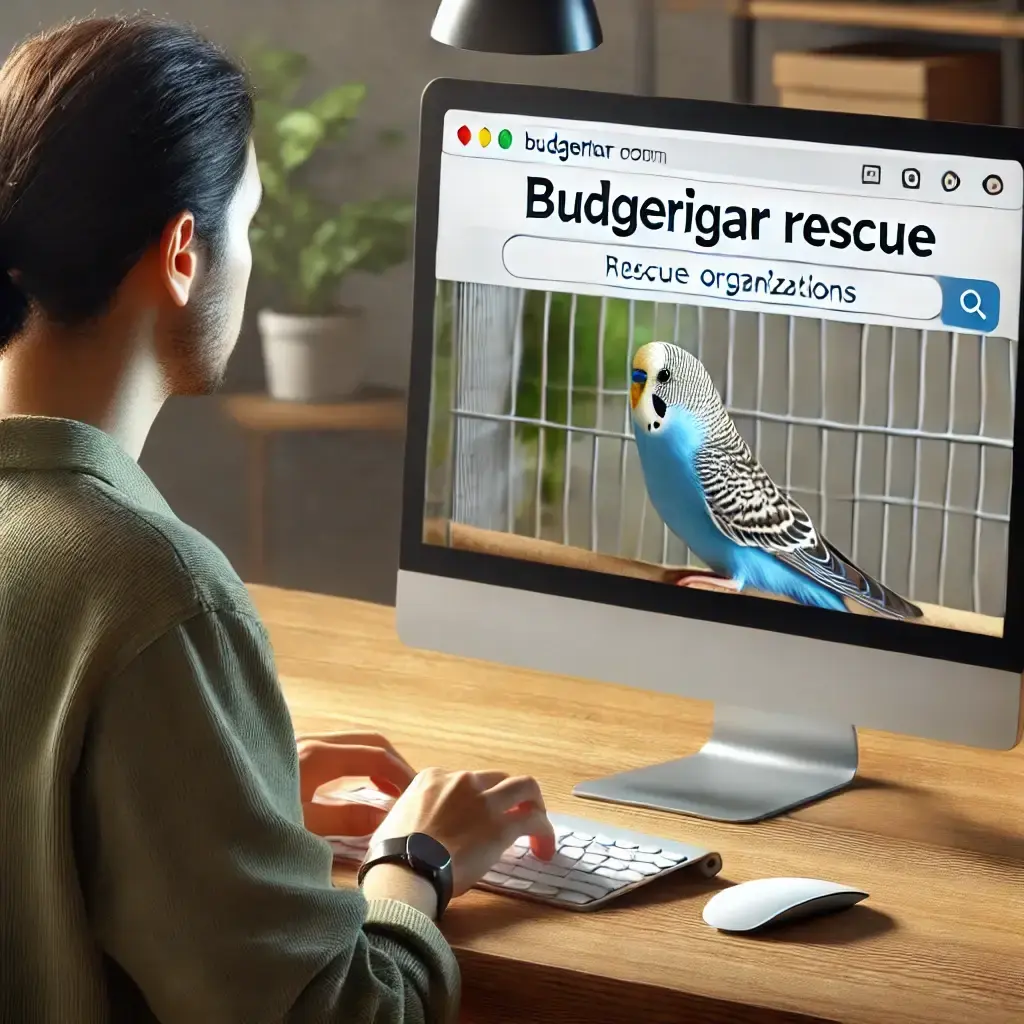
A person researching budgerigar rescue organizations online, the first step in the adoption process.
Local Animal Shelters
Local animal shelters often have birds, including budgerigars, available for adoption. While shelters primarily focus on dogs and cats, they frequently take in birds as well. Visiting or contacting your local animal shelter can lead you to a budgie in need of a home. You can find nearby shelters through a quick Google search or by using resources like the ASPCA’s shelter finder tool.
Avian Veterinarians
Avian veterinarians are excellent resources for finding budgerigar rescue organizations. They often work closely with rescue groups and can provide recommendations or referrals. If you already have a vet for other pets, ask them if they know of any reputable bird rescues. Even if they don’t specialize in avian care, they might have contacts who do.
Bird Clubs and Associations
Bird clubs and associations are communities of bird enthusiasts who often have connections to rescue organizations. These clubs can provide information on local rescues, adoption events, and even members who are looking to rehome their birds. Joining a bird club or attending their meetings can be a great way to network and learn about available budgerigars.
Word of Mouth
Sometimes the best way to find a budgerigar rescue organization is through word of mouth. Ask friends, family, or colleagues if they know of any bird rescues. You might be surprised at the connections people have. Additionally, pet stores often have bulletin boards with information about local rescues and adoption events.
Rescue Directories
There are online directories specifically for bird rescues. Websites like Bird Rescue Directory and Avian Welfare Coalition list reputable rescue organizations by state. These directories can help you find a budgerigar rescue near you and provide contact information and details about their adoption processes.
Adoption Events
Many rescue organizations hold adoption events where you can meet birds available for adoption. These events are often advertised on the rescue’s website or social media pages. Attending an adoption event can give you a chance to interact with budgerigars and talk to the rescuers about the adoption process and care requirements.
In conclusion, finding a budgerigar rescue organization involves utilizing online resources, local shelters, avian vets, bird clubs, word of mouth, rescue directories, and adoption events. With these methods, you can connect with a rescue organization and begin the rewarding journey of adopting a budgerigar in need.
Preparing for Budgerigar Adoption
Adopting a budgerigar is a rewarding experience, but it requires preparation to ensure a smooth transition for your new feathered friend. Here are some essential steps to get ready for budgerigar adoption.
Assessing Your Readiness
Before bringing a budgerigar home, it’s important to assess your readiness for adoption. Budgerigars, or budgies, need time, attention, and commitment. Ask yourself if you can dedicate time daily to interact with and care for your budgie. Consider your lifestyle and whether it can accommodate a pet that thrives on social interaction and stimulation.
Creating a Suitable Environment
A safe and comfortable environment is crucial for a budgerigar. Start by choosing the right cage. The cage should be spacious enough for the budgie to fly and move around comfortably. A minimum size of 18x18x24 inches is recommended. Ensure the bars are close enough to prevent the budgie from escaping or getting stuck.
Equip the cage with essential items such as perches, toys, food and water dishes, and a cuttlebone for beak maintenance. Place the cage in a location that is well-lit but away from direct sunlight and drafts. Budgerigars are sensitive to temperature changes, so keep the environment stable.

A cozy and stimulating environment prepared for a budgerigar, complete with colorful toys and accessories.
Gathering Supplies
Stock up on supplies before bringing your budgie home. This includes a variety of toys to keep them entertained, as budgies are intelligent birds that need mental stimulation. Rotating toys regularly can prevent boredom.
Buy high-quality budgie seed mix or pellets, fresh fruits, and vegetables to provide a balanced diet. Avoid foods that are harmful to budgies, such as avocado, chocolate, and caffeine. Having a supply of bird-safe cleaning products is also essential for maintaining a hygienic environment.
Understanding Budgerigar Behavior
Learning about budgerigar behavior can help you better care for your new pet. Budgies are social birds that enjoy interaction with their owners and other birds. They communicate through chirping, singing, and body language. Recognizing signs of stress or illness, such as changes in appetite, feather plucking, or lethargy, is important for early intervention.
Establishing a Routine
Budgerigars thrive on routine. Establish a daily schedule for feeding, cleaning the cage, and interacting with your budgie. Consistency helps them feel secure and reduces stress. Allow your budgie time outside the cage for exercise and socialization, but always supervise to ensure their safety.
Preparing for Health Care
Find a reputable avian veterinarian before bringing your budgie home. Regular check-ups are essential for maintaining their health. Familiarize yourself with common health issues in budgerigars, such as respiratory problems and nutritional deficiencies, so you can seek prompt veterinary care if needed.
Creating a Bonding Plan
Building a bond with your budgerigar takes time and patience. Start by allowing them to get used to their new environment and your presence. Talk to your budgie softly and offer treats to build trust. Gradually introduce your hand and encourage them to step up onto your finger. Positive reinforcement and consistency are key to developing a strong bond.
In summary, preparing for budgerigar adoption involves assessing your readiness, creating a suitable environment, gathering supplies, understanding budgie behavior, establishing a routine, preparing for health care, and creating a bonding plan. By taking these steps, you ensure a smooth transition and a happy, healthy life for your new budgerigar.
The Adoption Process
Adopting a budgerigar is a rewarding journey, but it’s important to understand the steps involved to ensure a smooth and successful experience. Here’s a detailed look at the adoption process for bringing a budgie into your home.
Initial Contact with Rescue Organizations
The first step in the budgerigar adoption process is to reach out to rescue organizations. You can find these organizations through online resources, local animal shelters, and avian veterinarians. Once you’ve identified a few potential rescues, contact them to inquire about the adoption process and available budgerigars. Most rescues will ask you to fill out an adoption application to assess your suitability as a pet owner.
Completing the Adoption Application
The adoption application is a crucial part of the process. It helps the rescue organization understand your experience with birds, your living situation, and your readiness to care for a budgie. Be honest and thorough in your responses. The rescue wants to ensure that each bird goes to a loving and suitable home.
The Home Visit
Some rescue organizations may conduct a home visit as part of the adoption process. This visit allows them to see where the budgerigar will be living and to offer advice on setting up the ideal environment. They may look at the cage setup, check for potential hazards, and provide tips on how to make your home safe and comfortable for your new pet.
Meeting Potential Budgerigars
Once your application is approved and the home visit is completed, you will have the opportunity to meet budgerigars available for adoption. Spend time interacting with different birds to find the one that best matches your personality and lifestyle. Rescue staff can provide insights into each bird’s temperament, health, and behavior, helping you make an informed decision.
Adoption Fees and Paperwork
If you find a budgie that you’d like to adopt, you will need to complete the adoption paperwork and pay an adoption fee. The fee helps cover the cost of the bird’s care, including medical check-ups and vaccinations. Review the adoption contract carefully, as it outlines your responsibilities as the new owner and the rescue’s policies.
Bringing Your Budgerigar Home
After the paperwork is complete, it’s time to bring your new budgerigar home. Transport your bird safely in a secure carrier, and ensure their cage is ready with food, water, perches, and toys. Give your budgie time to adjust to their new environment, and avoid overwhelming them with too much interaction initially.
Post-Adoption Support
Many rescue organizations offer post-adoption support to help you and your budgerigar settle in. Take advantage of this support if you have any questions or concerns. They can provide guidance on diet, behavior, and health care, ensuring a smooth transition for your new pet.

A rescue center volunteer interacting with a budgerigar, forming the bond that is crucial before adoption.
Regular Vet Check-ups
Schedule a vet check-up soon after bringing your budgerigar home. This ensures that your new pet is healthy and allows you to establish a relationship with an avian veterinarian. Regular check-ups are essential for maintaining your budgie’s health and catching any potential issues early.
In summary, the adoption process involves initial contact with rescue organizations, completing an adoption application, possibly undergoing a home visit, meeting potential budgerigars, handling adoption fees and paperwork, bringing your budgie home, and accessing post-adoption support. By understanding these steps, you can ensure a successful and rewarding adoption experience, providing a loving home for a budgerigar in need.
Caring for a Rescued Budgerigar
Caring for a rescued budgerigar requires patience, attention, and a good understanding of their needs. By providing the right environment, diet, health care, and socialization, you can ensure your budgie thrives in their new home.
Diet and Nutrition
A balanced diet is crucial for the health of your rescued budgerigar. Provide a mix of high-quality budgie seed or pellets, along with fresh fruits and vegetables. Budgies enjoy a variety of foods, so offer them leafy greens, carrots, apples, and berries. Avoid foods that are harmful to budgerigars, such as avocado, chocolate, and caffeine. Fresh water should always be available, and it’s important to clean their food and water dishes daily.

A person feeding and engaging with their budgerigar, demonstrating the daily care and interaction that budgerigars thrive on.
Health and Veterinary Care
Regular veterinary care is essential for maintaining your budgerigar’s health. Schedule an initial check-up soon after adoption and establish a routine for annual vet visits. Be vigilant about signs of illness, such as changes in appetite, droppings, or behavior. Common health issues in budgerigars include respiratory infections, feather plucking, and nutritional deficiencies. Early detection and treatment are key to ensuring your budgie’s well-being.
Socialization and Enrichment
Budgerigars are social birds that thrive on interaction. Spend time with your budgie daily, talking to them, and offering gentle interactions. Providing toys and activities is also important for their mental stimulation. Rotate toys regularly to keep them engaged, and consider foraging toys that challenge their intelligence. Mirrors, bells, and swings can be great additions to their environment.
Creating a Comfortable Environment
The right environment is vital for a happy and healthy budgerigar. Ensure their cage is spacious enough for them to fly and move around comfortably. Place perches of different sizes and textures to promote foot health. The cage should be located in a well-lit area but away from direct sunlight and drafts. Budgerigars are sensitive to temperature changes, so maintain a stable and comfortable environment.
Bonding and Building Trust
Building a bond with your rescued budgerigar takes time and patience. Start by allowing your budgie to get used to their new surroundings. Sit near their cage and talk to them softly to help them get accustomed to your presence. Gradually introduce your hand, offering treats and encouraging them to step up onto your finger. Positive reinforcement and consistency are key to building trust and a strong bond.
Exercise and Playtime
Exercise is important for your budgerigar’s physical health. Allow them supervised time outside the cage to stretch their wings and explore. Ensure the area is bird-proofed, free from hazards like open windows or toxic plants. Interactive playtime helps prevent boredom and promotes a healthy, active lifestyle.
Monitoring Behavior
Understanding your budgerigar’s behavior can help you provide better care. Watch for signs of stress or discomfort, such as excessive biting, screaming, or feather plucking. These behaviors can indicate underlying issues that need attention. Providing a stable routine and a secure environment can help reduce stress and promote positive behavior.
In summary, caring for a rescued budgerigar involves providing a balanced diet, regular veterinary care, socialization, a comfortable environment, bonding time, exercise, and behavior monitoring. By meeting these needs, you can ensure your budgie thrives in their new home and enjoys a happy, healthy life.
Common Challenges and Solutions
Adopting a rescued budgerigar is a rewarding experience, but it can come with some challenges. Here are common issues you might face and practical solutions to ensure your budgie’s well-being and happiness.
Behavioral Issues
Challenge: Rescued budgerigars may exhibit behavioral issues due to past trauma or neglect. Common behaviors include excessive biting, screaming, or feather plucking.
Solution: Patience and consistency are key to addressing behavioral problems. Start by building trust through gentle interaction and positive reinforcement. Avoid sudden movements and loud noises that might scare your budgie. Offer toys and activities to keep them mentally stimulated and engaged. Consult an avian behaviorist if needed for specialized guidance.
Health Concerns
Challenge: Rescued budgerigars might have underlying health issues that require attention. Common problems include respiratory infections, nutritional deficiencies, and parasites.
Solution: Regular veterinary check-ups are essential for early detection and treatment of health issues. Ensure your budgie has a balanced diet rich in essential nutrients. Maintain a clean environment by regularly cleaning the cage and food dishes. If you notice any signs of illness, such as changes in droppings, appetite, or behavior, seek veterinary care promptly.
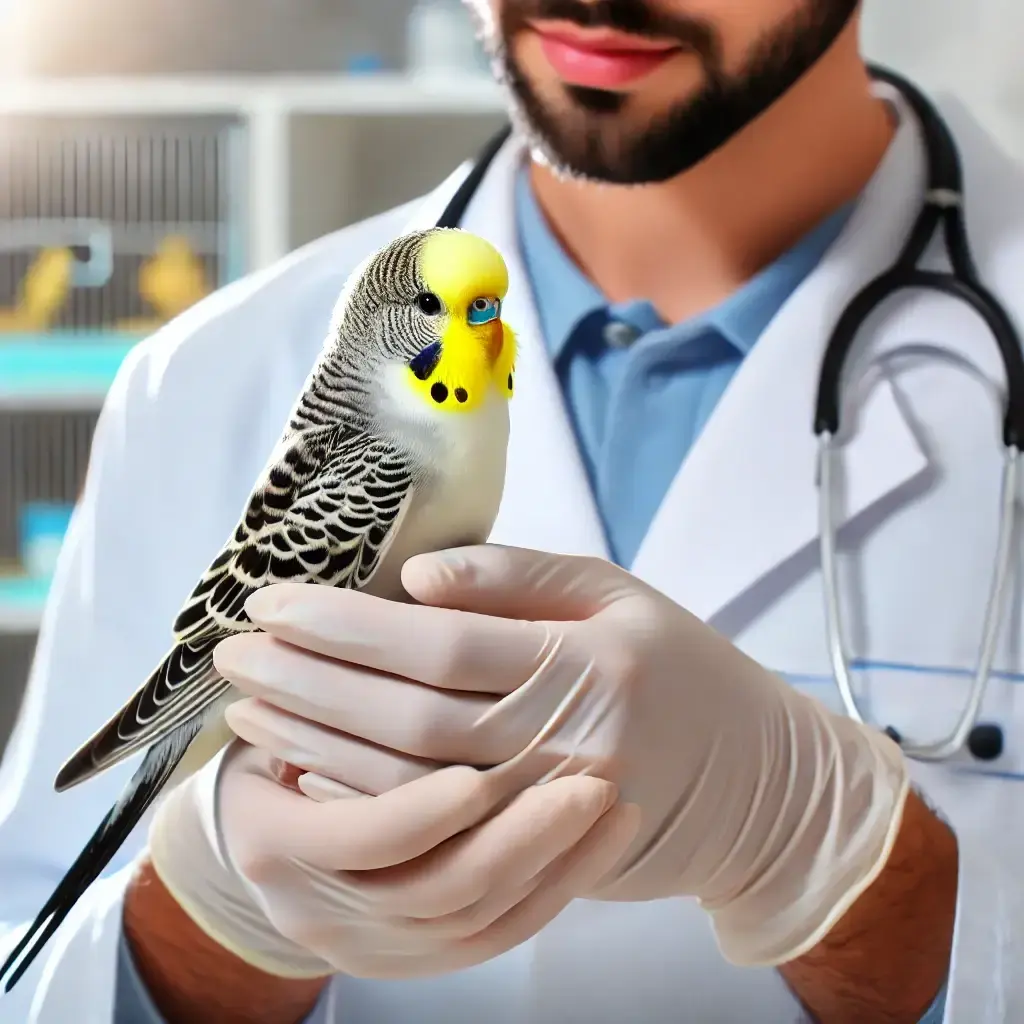
A budgerigar undergoing a routine veterinary check-up, highlighting the importance of health checks before adoption.
Socialization and Bonding
Challenge: Building a bond with a rescued budgerigar can take time, especially if the bird has had negative experiences with humans.
Solution: Spend time near your budgie’s cage, talking softly to help them get accustomed to your presence. Gradually introduce your hand, offering treats and gentle encouragement to step up. Consistent, positive interactions will help build trust and strengthen your bond over time.
Diet and Eating Habits
Challenge: Some rescued budgerigars might be picky eaters or unfamiliar with a balanced diet.
Solution: Introduce new foods gradually, mixing them with familiar items to encourage acceptance. Offer a variety of fresh fruits, vegetables, and high-quality seeds or pellets. Monitor your budgie’s eating habits and adjust their diet to ensure they receive all necessary nutrients. Consult an avian veterinarian for dietary recommendations if needed.
Integration with Other Pets
Challenge: Introducing a new budgerigar to a home with other pets can be stressful for the bird and other animals.
Solution: Ensure a safe, separate space for your budgie initially, allowing them to acclimate to their new environment. Gradually introduce them to other pets under close supervision. Keep interactions short and positive, rewarding calm behavior. Always prioritize your budgie’s safety and well-being during these introductions.
Fear and Stress
Challenge: Rescued budgerigars might experience fear and stress in a new environment.
Solution: Create a calm and stable environment by minimizing loud noises and sudden changes. Provide plenty of hiding spots and cover part of the cage to offer a sense of security. Establish a routine for feeding, cleaning, and interaction to help your budgie feel secure. Using gentle, reassuring tones can also help alleviate stress.
Lack of Exercise
Challenge: Ensuring your budgerigar gets enough exercise can be challenging, especially in a confined space.
Solution: Provide a spacious cage with room for flying and climbing. Include perches, swings, and ladders to encourage movement. Allow supervised time outside the cage in a safe, bird-proofed area. Engaging toys and activities can also promote physical activity and prevent boredom.
In summary, while adopting a rescued budgerigar comes with challenges, these can be managed with patience, care, and consistency. By addressing behavioral issues, health concerns, socialization, diet, integration with other pets, fear, stress, and exercise needs, you can ensure a happy and healthy life for your budgie.
Success Stories: Budgerigar Rescues with Happy Endings
Budgerigar rescue and adoption can lead to heartwarming transformations and joyful outcomes. Here are a few success stories that highlight the incredible impact of giving these delightful birds a second chance.
Charlie’s New Beginning
Charlie was found abandoned in a park, scared and undernourished. A local budgerigar rescue organization took him in, providing the care and love he desperately needed. After a few weeks of rehabilitation, Charlie was ready for adoption. When the Johnson family met him, they knew he was the perfect addition to their home. With plenty of attention and a stimulating environment, Charlie thrived. Today, he’s a happy, playful budgie who loves to sing and interact with his new family.
Luna’s Transformation
Luna was surrendered to a rescue center because her previous owner could no longer care for her. She was shy and hesitant around people. The rescue team worked patiently with Luna, offering gentle interactions and plenty of enrichment activities. When Emma, an experienced bird owner, adopted Luna, she continued this patient approach. Over time, Luna’s personality blossomed, and she became a confident and affectionate companion. Luna’s transformation is a testament to the power of patience and love.
Max’s Journey to Health
Max arrived at the rescue with severe nutritional deficiencies and a respiratory infection. The dedicated rescue staff provided immediate veterinary care and a nutritious diet to nurse him back to health. Max’s recovery was slow but steady. Once healthy, he was adopted by the Garcia family, who provided a spacious cage, a balanced diet, and plenty of interaction. Max now enjoys a vibrant, healthy life, chirping happily and exploring his environment every day.
Bella’s Socialization Success
Bella was a timid budgerigar who had never been socialized properly. The rescue organization focused on building her confidence through positive reinforcement and gentle handling. When the Parkers adopted Bella, they continued these practices, offering her a safe and loving home. Bella gradually warmed up to her new family and even started mimicking their whistles and words. She now enjoys interacting with her human family and playing with her bird toys.
Rocky’s Second Chance
Rocky was found injured and weak by a kind-hearted passerby, who took him to a budgerigar rescue center. The rescue team provided immediate medical attention and a safe space for Rocky to recover. His resilience and spirit shone through, and he made a full recovery. The Smith family, looking for a budgie to adopt, fell in love with Rocky’s spunky personality. Today, Rocky is a lively, energetic budgie who brings joy to his new home.
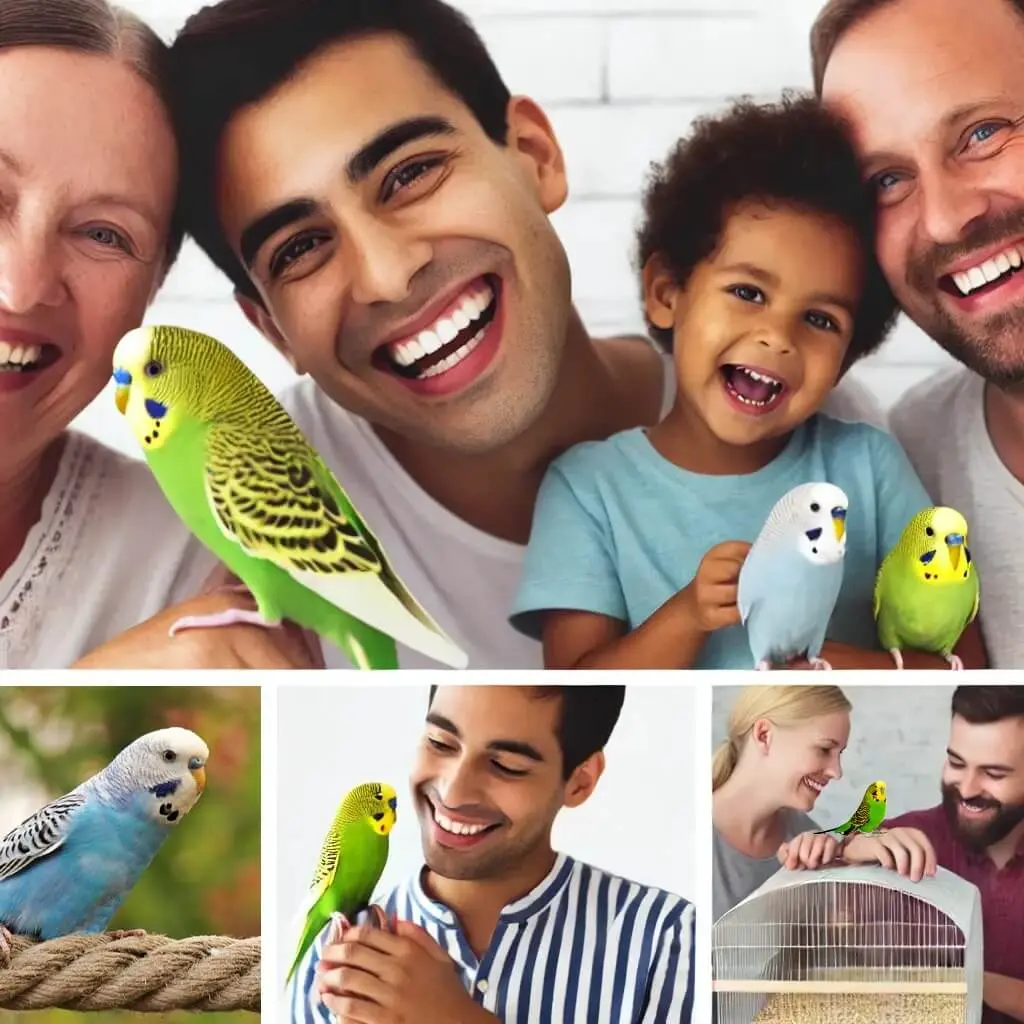
A collage featuring various families joyfully bonding with their adopted budgerigars, showing the positive outcomes of rescue and adoption.
Tips for a Happy Adoption
These success stories highlight the positive impact of budgerigar rescue and adoption. Each bird’s journey to a loving home underscores the importance of patience, proper care, and a nurturing environment. If you’re considering adopting a budgie, remember that your compassion and dedication can turn a rescued bird’s life around.
In conclusion, budgerigar rescues often result in happy endings, thanks to the dedication of rescue organizations and the loving homes that adopt these birds. These success stories demonstrate that with the right care and attention, rescued budgies can thrive and bring immense joy to their new families. By choosing budgerigar rescue and adoption, you too can create a happy ending for a bird in need.
Conclusion
Adopting a budgerigar from a rescue organization is a compassionate and rewarding choice. By considering budgerigar rescue, you provide a second chance to a bird in need, support ethical practices, and experience the joy of bringing a new feathered friend into your life.
From understanding the importance of rescue to finding the right organization, preparing for adoption, and navigating common challenges, this guide has equipped you with the knowledge to ensure a successful and fulfilling adoption experience. Caring for a rescued budgerigar requires commitment, but the rewards of watching your budgie thrive in a loving home are immeasurable.
Remember, each budgerigar has a unique story and personality, and with patience, love, and proper care, you can help your new pet flourish. Whether you’re a first-time bird owner or expanding your flock, adopting a budgie is a step towards a happier life for both you and your new companion.
Choose budgerigar rescue and adoption, and be part of a heartwarming journey that changes lives for the better. By giving a budgie a second chance, you’re not just gaining a pet; you’re making a difference.
Frequently Asked Questions (FAQs)
What is budgerigar rescue?
Budgerigar rescue involves taking in budgerigars that are abandoned, neglected, or surrendered by their owners. Rescue organizations provide these birds with the care they need and find them new, loving homes.
Why should I adopt a budgerigar instead of buying one from a pet store?
Adopting a budgerigar supports ethical practices, reduces the demand for commercial breeding, and gives a bird a second chance at a happy life. Rescue birds often receive thorough health checks and socialization, making them well-prepared for adoption.
How can I find a reputable budgerigar rescue organization?
You can find budgerigar rescue organizations through online resources, local animal shelters, avian veterinarians, bird clubs, and rescue directories. Social media and word of mouth are also helpful in locating reputable rescues.
What should I expect during the budgerigar adoption process?
The adoption process typically includes filling out an application, a possible home visit, meeting available budgerigars, paying an adoption fee, and completing the necessary paperwork. Rescue organizations ensure that the bird is a good match for your home and lifestyle.
How do I prepare my home for a rescued budgerigar?
Prepare a spacious cage with perches, toys, food and water dishes, and a cuttlebone. Place the cage in a well-lit area away from direct sunlight and drafts. Ensure you have a balanced diet ready, including seeds, pellets, and fresh fruits and vegetables.

A person reading a comprehensive guidebook on budgerigar care, essential for new and prospective bird owners.
What are common challenges in caring for a rescued budgerigar?
Common challenges include behavioral issues, health concerns, socialization, diet, integration with other pets, fear, and stress. Each of these challenges can be managed with patience, proper care, and consistency.
How can I build trust with my rescued budgerigar?
Building trust takes time and patience. Spend time near the cage, talk softly to your budgie, and offer treats. Gradually introduce your hand and encourage your budgie to step up. Consistent, positive interactions are key to building a strong bond.
What should I feed my rescued budgerigar?
Provide a balanced diet of high-quality seed mix or pellets, along with fresh fruits and vegetables. Ensure fresh water is always available. Avoid foods that are harmful to budgerigars, such as avocado, chocolate, and caffeine.
How often should I take my budgerigar to the vet?
Schedule an initial vet check-up soon after adoption and follow up with annual check-ups. Regular veterinary visits are essential for maintaining your budgerigar’s health and catching any potential issues early.
Can I adopt more than one budgerigar?
Yes, budgerigars are social birds that often thrive with a companion. If you have the space and resources to care for multiple birds, adopting more than one can provide them with additional social interaction and enrichment.
In summary, adopting a budgerigar from a rescue organization involves understanding the rescue process, preparing your home, and being ready to meet the bird’s needs. By considering these FAQs, you can make informed decisions and provide a loving home for your new feathered friend.

